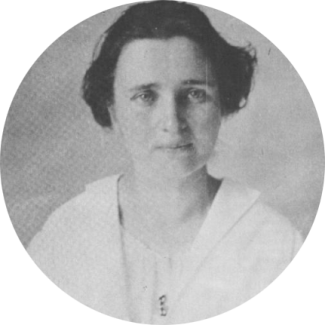Tatiana Apollonovna Schucht (Татьяна Аполлоновна Шухт, Tat'jana Apollonovna ukht) was born in Samara on 15 January 1887. In 1894, she relocated with her family to Geneva, and then, in 1903, to Montpellier. There she was to complete her secondary-school studies and begin attending university courses in the faculty of medicine. In late 1908, the Schucht family relocated to Rome; there, in early 1909, Tatiana enrolled in the faculty of natural sciences, earning her degree on 21 July 1913. At the end of that same year, she enrolled in the faculty of medicine, attending courses until 1917, but sitting only one examination. She most likely met Livia Lollini, the daughter of Socialist deputy Vittorio, and Nilde Perilli, classmate of her sister Eugenia, who helped her learn Italian, during her university period. Beginning in 1912, she taught maths and sciences (and, starting in 1920, French as well) at the Crandon international institute, while also giving private lessons. In 1914, she had a brief experience as an editor at the International Institute of Agriculture. Between 1915 and 1916, she served as a nurse at Rome's Policlinico "Umberto I." In 1916, she offered her services as a teacher at a school for malarial children in Ariccia, where Nilde Perilli also worked. In October 1916, when her father and brother Vittorio decided to return to Moscow, she opted to remain in Italy. During these years, moving home frequently, she had sporadic contact with her family. In February 1925, she was tracked down in Rome, while a tenant of the Schreider family, by Antonio Gramsci, who had been tasked by Julia with finding her sister. Probably at her brother-in-law's urging, she began to work with the Soviet Embassy in Rome as a translator. She translated from the Russia Bukharin's Historic Materialism, which Gramsci used for the Party school's lecture notes. In October 1925, upon the arrival in Rome of her sisters Julia and Eugenia, she lived with them and young Delio in the house at Via Trapani 12. During the days following Gramsci's arrest, she visited Via Morgagni 25 on a number of occasions to recover the writings and volumes kept there. In May 1927, she visited Milan for the first time to meet with Gramsci who was imprisoned at San Vittore, but fell ill and was hospitalized at Ospedale Maggiore for four months. Only on 5 September did she manage to meet with Gramsci. After this first encounter, she was able to have additional meetings with her brother-in-law until January 1928 when, due to pneumonia, she was again hospitalized until the month of May. In June that same year, following Gramsci's transfer to Rome for the "processone" or the "big trial," she returned to the capital where she had some meetings with him prior to his departure for Turi. In September 1928, she moved to Milan, employed at the Soviet trade representation. In October 1928, she met Piero Sraffa for the first time. In December 1928, she visited Turi, where she wrote the first reports on Gramsci's prison conditions. In March 1929, she was again in Turi, and then returned to Rome, leaving again in the month of December and staying in Turi until June 1930. Her meeting with Gennaro Gramsci, who had come to Turi to visit his brother, dates to this month. Due to this prolonged absence, she was fired by the Milanese Representation; in July 1930, she returned to live in Rome, first with the Schreider family, then with the Perilli family, and recommenced giving private lessons. In 1932, in spite of Sraffa's repeated urging, she did not visit Turi; in September that same year, she started the paperwork for Gramsci to be examined by a specialist. She returned to Turi in January 1933, where she remained until August, and where in March 1933 she met professor Uberto Arcangeli, who had come to the Apulian town to examine Gramsci. Along with Sraffa, she dealt with the paperwork necessary to apply for the amnesty and pardon decree. Upon Gramsci's transfer to the Cusumano Clinic in Formia, she started visiting her brother-in-law every Sunday. In November 1934, she got herself hospitalized at the same clinic for ten days, thus having daily contacts with Gramsci. After his death, she dealt with the paperwork for his cremation and burial, purchasing in the Schucht family's name the tomb at Cimitero Acattolico. She also secured all the documentation Gramsci produced during his years of imprisonment, which she entrusted to the Soviet Embassy to send to Moscow. She started - without completing it - to write a detailed catalogue of the topics dealt with in the Notebooks. Until September 1938, she continued her correspondence with Sraffa; she returned to Moscow in December that same year. On 25 February 1939, she attended the first meeting of the "Committee for the literary heritage of Antonio Gramsci," later to be replaced by her sister Eugenia. Unable to find any other type of employment, she continued giving private lessons at home. During the War, she asked to be employed as a nurse at the front, but her application was denied due to her shaky health. She was in fact hospitalized for some time in the Kislovodsk sanatorium. In 1941, she took refuge with her family in Frunze (now Bikek) in Kyrgyzstan, where she died of abdominal typhus on 27 September 1943.

